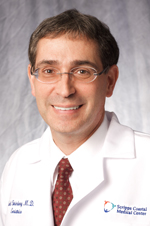Today SevenPonds concludes our discussion with Dr. Karl Steinberg, MD. about his two-decade medical practice focusing on palliative and hospice care. (Read Part One here.) Dr. Steinberg is the medical director of three nursing homes and Hospice by the Sea (since 1995). He currently sits on the board of directors at AMDA (American Medical Doctors Association) where he focuses on post-acute and long-term medicine. He also chairs the Coalition for Compassionate Care of California, which in his words is, “a great organization all about helping people make sure they get the kinds of treatment they want, and not get the kinds of treatment they don’t want.” Dr. Steinberg is also the editor-in-chief of a periodical AMDA puts out called Caring for the Ages.
Juniper: What are your thoughts about the physical and organizational structure of palliative care facilities in America today? In your opinion, how could that shift to better serve the needs of your patients?

Dr. Karl E. Steinberg, MD.
(Credit: scripps.org)
Dr. Steinberg: The specialty palliative workforce is tiny — that’s a big issue. Most larger hospitals — the teaching hospitals — now have a palliative care service, but each one is unique. Some might be just a doctor and social worker; some teams may include a wider scope of professionals. And some of these teams don’t get utilized appropriately. You’d think that anyone who’s been in ICU for five days or more should have access to this service, but they’re not always linked up with it because the specialists don’t want to hear it.
Out of nearly 100,000 medical doctors in the United States, only 900 have certification in palliative care. Not everyone needs a certification to provide reasonable palliative care, but it’s worth noting that the workforce is limited. Palliative care has the potential to expand due to recent studies showing that palliative care alongside curative care generally makes the curative treatment more effective. So, I think this message needs to be carried strongly into the primary care workforce.
Because of the American standard that a patient must be willing to forgo curative treatments such as chemotherapy in order to enter hospice, as well as be within the last six months of their lives, it will be difficult to create this functional shift before other administrative adjustments are made. I would also like to see greater access to in-home palliative care. Palliative care isn’t just about helping people die. It’s about increasing quality of life for the patient and their family. It also focuses on getting symptoms under control.

Credit: www.cohealth.com
Juniper: What are the greatest challenges to patients who require access to long-term (beyond 6 months) palliative care?
Dr. Steinberg: This boils down to a workforce issue again — there aren’t enough professionals around to provide quality in-home palliative care, regardless of cost. MediCare pays for hospice but they won’t keep people on it for years without any sign of decline. So, in the case of advanced dementia, for example, we want to find a way for patients to retain comfort and dignity. If a palliative team can’t provide care anymore because of legislation or workforce capacity, this may mean that a patient will end up in a nursing home. That’s a sad reality for some folks. This has been happening more often as a result of hospices coming under fire for admitting people and keeping them on even though they were clearly stable for several years, suggesting that hospices are just in this for a cash grab. So, we as a medical community need to come clear on the benefits and reasonable applications of palliative medicine.

Credit:verywell.com
In California, we just passed the End-of-Life Options Act, a law that allows physicians to assist a patient’s death by prescribing a lethal drug. I haven’t been asked for this yet, though I’ve been asked many times in the past. There are many safeguards built into the law, so I want people to know that the option to stop eating and drinking is always there as well. People will usually die within 10 to 14 days. Although the public seems to think that dying of dehydration is a horrible thing, patients tend to die very peacefully. The mouth gets dry naturally during the dying process, and we can spray the mouth with a solution called Biotene that makes the patient more comfortable.
Sometimes when a patient has had a stroke and they can’t swallow and their body is already shutting down, the cessation of food and drink is a preferred way to die. I’m not flying the flag for this option, but I believe it’s a more benign exit than taking a handful of Seconal. It gives you time to change your mind. So, if you’re three or four days in and decide that you don’t want to die yet, then you can act on that.

Credit: npexcellence.com
Juniper: In your opinion, should all doctors receive training in palliative medicine, or at least an awareness of how to have end-of-life discussions with their patients?
Dr. Steinberg: I definitely support mandatory palliative medicine education — and lots of it — across the board, both at the graduate level (in medical school) and during residencies, assuming that you’ll be taking care of live patients. The situation may be different, of course, if you’re an aspiring professional going into a more research or lab-based area.
There have been some great advances recently, such as the Ariadne Project out of Harvard University, and Vital Talk. A short while ago I was looking at the short videos on the Vital Talk site — I haven’t taken their full on training yet, but probably will — and was amazed at the ways they had of saying things that had not occurred to me, and which I’ll probably use in the future. I’m imaging that this program would help a professional who isn’t comfortable having end-of-life discussions with their patients ask questions such as, “If you were to go into a cardiac arrest, how aggressive do you want your treatment to be?”
It’s super important to spend time thinking about and practicing that level of talking. As a profession, it’s our responsibility to give patients adequate prognoses and life expectancies and talk about the common things that will experienced along the way. This information will help them make more informed decisions about their own care that will ultimately be less costly and more humane for everyone involved.
Juniper: Thanks very much, Dr. Steinberg. It’s been a pleasure speaking with you.

 What is a Doctor’s Role in Advance Care Planning? An Interview with Dr. Karl Steinberg, MD: Part Two
What is a Doctor’s Role in Advance Care Planning? An Interview with Dr. Karl Steinberg, MD: Part Two


 Our Monthly Tip: Make an “In Case of Death” File to Ease Loved One’s Grief
Our Monthly Tip: Make an “In Case of Death” File to Ease Loved One’s Grief
 Passing of Beloved Comedian Births a New Comedy Festival
Passing of Beloved Comedian Births a New Comedy Festival















